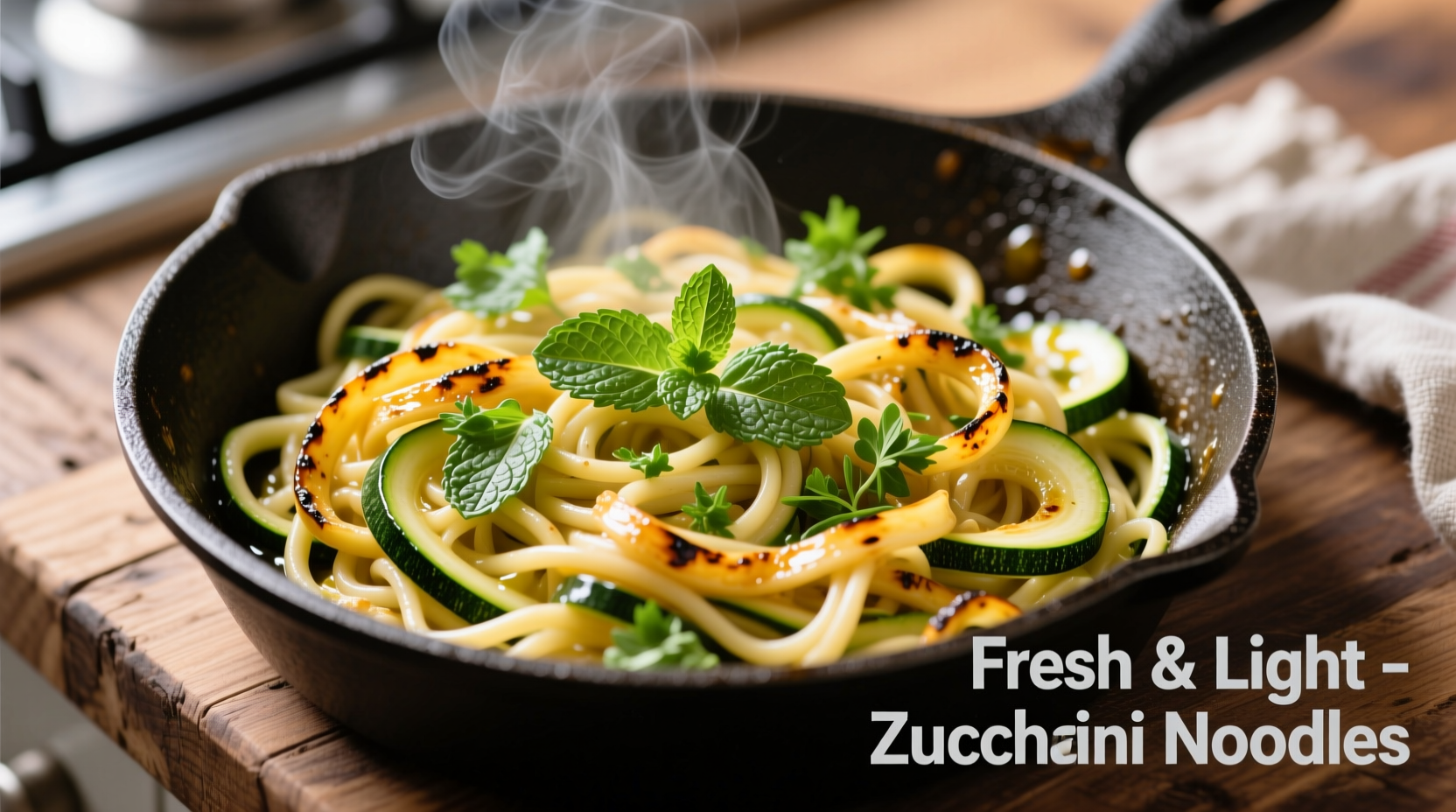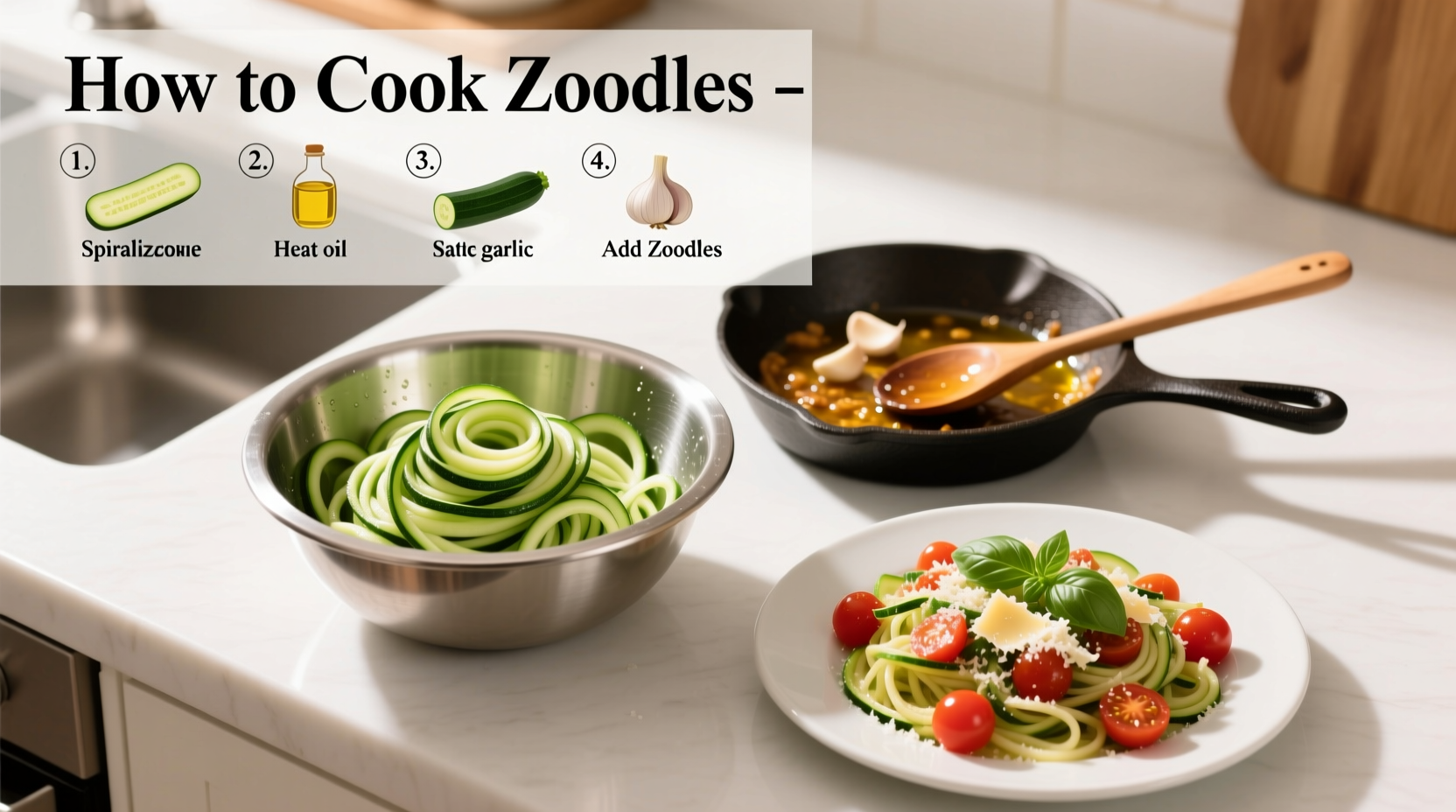Transforming zucchini into satisfying "zoodles" requires specific techniques that differ from traditional pasta preparation. Many home cooks struggle with watery, mushy results because they treat zoodles like regular noodles. The secret lies in understanding zucchini's high water content (about 95% by weight according to USDA agricultural data) and adapting your cooking method accordingly.
Why Zoodles Need Special Treatment
Zucchini contains significantly more water than wheat-based pasta, making standard boiling methods disastrous for texture. When cooked improperly, zoodles release water during preparation, creating a soggy mess that won't properly absorb sauces. Food science research from the Institute of Food Technologists confirms that vegetables with high moisture content like zucchini require moisture management before cooking to achieve optimal texture.
Essential Preparation: Removing Excess Moisture
This critical step makes or breaks your zoodles. After spiralizing:
- Sprinkle 1 teaspoon of kosher salt per medium zucchini over the strands
- Let sit in a colander for 20-30 minutes (time varies by zucchini size)
- Gently squeeze handfuls in a clean kitchen towel to extract additional moisture
- Pat dry with paper towels before cooking
This process draws out approximately 30% of the water content, preventing dilution of your sauce and ensuring proper texture. The FDA recommends this moisture removal technique for vegetable-based pasta alternatives to maintain food safety and quality during preparation.
Cooking Methods Compared
| Cooking Method | Time Required | Texture Result | Best For |
|---|---|---|---|
| Sauteing | 2-3 minutes | Firm, slightly al dente | Most sauces, quick meals |
| Raw | 0 minutes | Crisp, fresh | Cold dishes, pesto sauces |
| Steaming | 3-4 minutes | Soft but intact | Delicate sauces |
| Oven Roasting | 8-10 minutes | Firm edges, tender center | Baked dishes, casseroles |
Perfect Sauté Technique: Step-by-Step
For restaurant-quality results at home:
- Heat 1 tablespoon olive oil in a large skillet over medium-high heat until shimmering (about 375°F)
- Add thoroughly dried zoodles in a single layer (work in batches if needed)
- Cook undisturbed for 60-90 seconds to develop slight caramelization
- Gently toss with tongs for another 60-90 seconds until just tender
- Remove immediately from heat to prevent carryover cooking

Avoid These Common Zoodle Mistakes
Even experienced cooks make these errors that ruin zucchini noodles:
- Skipping the salt step - Moisture ruins texture and dilutes sauce
- Overcrowding the pan - Creates steam instead of sautéing
- Cooking too long - Zoodles become mushy in under 30 seconds past ideal point
- Adding sauce too early - Wait until after cooking to prevent water release
Serving Suggestions for Maximum Flavor
Pair your perfectly cooked zoodles with these complementary flavors:
- Classic marinara with fresh basil and parmesan
- Lemon garlic sauce with cherry tomatoes
- Pesto with toasted pine nuts
- Asian-inspired sesame ginger sauce
For optimal results, toss zoodles with sauce immediately before serving. Unlike traditional pasta, zoodles don't require sauce absorption time. The USDA recommends consuming vegetable-based noodles within 2 hours of preparation for best quality and food safety.
Storage and Meal Prep Tips
Properly stored, uncooked zoodles last 3-4 days in the refrigerator. The National Center for Home Food Preservation advises:
- Store prepared but uncooked zoodles in an airtight container with paper towels
- Change paper towels daily to absorb excess moisture
- Cooked zoodles keep for 2-3 days but lose texture quality
- Freezing isn't recommended as it destroys the delicate structure
Frequently Asked Questions
How long should I cook zoodles for the best texture?
Sauté zoodles for just 2-3 minutes total in a hot pan. Overcooking by even 30 seconds turns them mushy. The ideal texture is slightly tender with a crisp bite remaining - they should still hold their spiral shape when twirled with a fork.
Can I boil zoodles like regular pasta?
Boiling zoodles is not recommended as it makes them extremely watery and mushy. The high water content of zucchini means boiling releases too much moisture, destroying the noodle structure. Sautéing or eating raw produces far superior results for zucchini noodles.
Why do my zoodles always turn out watery?
Watery zoodles typically result from insufficient moisture removal before cooking. Always salt and drain spiralized zucchini for 20-30 minutes, then squeeze gently to remove excess water. Skipping this critical step causes the zucchini to release water during cooking, creating a soggy mess that won't properly absorb sauce.
What's the best tool for making zoodles?
A spiralizer produces the most consistent zoodle results, but you can also use a julienne peeler, mandoline slicer, or even a regular vegetable peeler. Electric spiralizers work fastest for large batches, while handheld models offer more control for delicate zucchini. For best cooking results, aim for uniform thickness in your zoodles.
How do I prevent zoodles from becoming soggy when storing leftovers?
Store uncooked zoodles with paper towels in an airtight container to absorb moisture. For cooked leftovers, separate zoodles from sauce and store them in a single layer with paper towels between layers. Reheat in a hot skillet rather than the microwave to restore texture. Even with proper storage, zoodles are best consumed within 24 hours for optimal quality.











 浙公网安备
33010002000092号
浙公网安备
33010002000092号 浙B2-20120091-4
浙B2-20120091-4